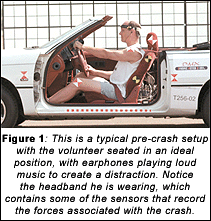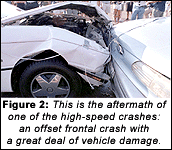As a practitioner, you know foot pain should be addressed as soon as possible, as pain in one or both feet can potentially lead to impairment of foot function. But rather than treating foot pain with over-the-counter pain and anti-inflammatory medications such as ibuprofen, or prescription nonsteroidal anti-inflammatory drugs (NSAIDs), or even corticosteroid injections for chronic foot pain, why not try red light / infrared therapy?
Notable Observations from Three Years of Human-Subject Crash Testing
The Spine Research Institute has sponsored three annual human-subject crash tests, beginning with CRASH 1999 (named after the Center for Research into Automotive Safety and Health). These tests have totaled almost 50 individual crashes, with vehicle closing speeds ranging from 2-50 mph. The outcome of this research has given rise to a number of papers that have appeared in such publications as Accident Analysis and Prevention, and presentations at the International Congress on Whiplash-Associated Disorders; the International Research Council on the Biomechanics of Impact (IRCOBI); and the Association for the Advancement of Automotive Medicine annual conference. Since many of our chiropractic colleagues are not familiar with these findings, we thought it would be beneficial to provide an overview of some of our more notable observations. While we could have mentioned many more, the following is a list of six observations we believe every chiropractic physician who treats whiplash patients should understand:
| Crash number and year of crash | Gender and direction of impact (front, rear) | Vc (mph at time of crash) | 
(change in mph, or delta V) | Head linear resultant acceleration (g) |
| 2 (99) 3 (99) 4 (99) 5 (99) 6 (99) 7 (99) 8 (99) 9 (99) 15 (99) 1 (00) 2 (00) 3 (00) 6 (00) 7 (00) 8 (00) 9 (00) 10 (00) 11 (00) 12 (00) 13 (00) 5 (01) 6 (01) | M (R) M (R) F (R) F (R) F (R) F (R) F (R) F (R) M (F) M (R) M (R) M (R) M (F) F (F) F (F) F (F) F (R) F (R) F (R) M (R) M (R) M (R) | 9.3 9.9 3.7 7.2 6.6 4.1 7.2 7.0 36.9 4.8 7.8 8.3 7.7 4.2 7.9 9.9 3.0 7.5 8.6 3.6 8.1 8.0 | 5.2 6.0 3.2 5.8 5.6 3.3 5.7 5.2 17.1 3.8 5.8 5.9 5.5 3.2 5.6 7.1 2.8 6.0 6.7 2.9 5.0 4.8 | 12.5 13.0 5.6 11.1 13.5 6.8 12.8 8.9 10.3 5.0 12.7 8.2 2.9 1.7 3.1 4.6 2.9 12.8 15.0 4.0 7.8 5.0 |
| Table 1. Selected crash sequences from CRASH 1999 and 2000. | ||||
- Occupants may experience significant head accelerations without noticeable vehicle bumper damage.
- Occupants of (target) vehicles struck from the rear undergo approximately three times the amount of force acting on the cervical spine, compared with occupants of striking (bullet) vehicles.
- Vehicle speed changes are not linearly associated with occupant head accelerations.
- In rear-impact collisions, females (or smaller persons) generally experience greater resultant head acceleration than do males (or larger persons).
- Most vehicles tested have been able to withstand impacts resulting in delta Vs in excess of five miles per hour without noticeable vehicle bumper damage.
- Occupants who are aware and braced in rear-impact collisions experience significantly less head acceleration and less violent neck kinematics than do unaware and unbraced occupants.
The crash tests are carried out in a precise manner, utilizing established engineering practice. Institutional review board approval for human subject research is granted prior to testing in accordance with the Helsinki Doctrine. The informed and consenting human subjects (male and female) are instrumented with accelerometers, and then individually placed in instrumented crash test vehicles. Occupant accelerations are recorded for the head, thorax, and lumbar spines. Forces and moments can be calculated based on head accelerations and the principles of dynamics. Vehicle accelerations, closing velocities, and speed changes are recorded. Volunteers are subjected to rear, frontal and side-impact crashes, most of which are conducted in the "unaware" mode (subjects had no visual clues as to the time of impact and are distracted with loud music played through earphones). A few are in the "aware" mode, in which the subjects are allowed to brace for the impact. The data from a portion of the total number of crashes conducted in 1999 and 2000 is shown in Table 1.
One of our major purposes for this crash series was to compare the occupant kinematics and forces between the bullet and target vehicles. The same instrumented subjects underwent crash sequences with the same speed changes in the same vehicles under bullet and target conditions. Based on the recorded data, as well as observation of high-speed video, it is clear that the occupant kinematics and forces are dramatically different between the two crash conditions: being rear-ended is much more traumatic than rear-ending another vehicle when the subject, vehicle, and speed change are held constant.
This also addresses the common question: "How come it's always the guy in the front car who gets hurt?" A good example of this event is evident when comparing crash 9 (00) of Table 1, a frontal impact involving a female subject with a delta V of 7.1 mph and 4.6 g head acceleration; with crash 12 (00), a rear impact involving the same female subject with a 6.7-mph delta V and a remarkable 15g head acceleration.
We previously indicated that speed changes are not linearly associated with occupant head accelerations. Again, refer to Table 1, and compare crash 15 (99), a 17.1-mph delta V and 10.3g head acceleration, with crash 2 (99), where the subject experienced more significant head acceleration at only 5.2 mph delta V. The higher-speed crash test resulted in very significant crush damage to both crash test vehicles. This increased the duration of the high-speed crash test, and the resulting head acceleration to the driver of the bullet vehicle was relatively lower. Our findings in this area would be vital to present to attorneys, claims adjusters, and juries in certain real-world cases.

Another interesting finding is that multiple crash sequences can be performed within the crash metrics corridor, of which the upper boundary is generally held to be above the level that could produce injuries to human subjects (i.e., 5-mph delta V) without causing significant damage to the test vehicles. This is consistent with most of the other reported crash testing in the literature. Several of these nondamaging crash sequences are at closing speeds of nearly 10 mph. These observations are significant in light of the common myth that one can predict occupant injury from examining the vehicle damage, or that the absence of property damage is a reliable indication that the crash speeds must have been below the published bumper ratings. As a matter of fact, we exceeded these bumper ratings in nearly every test.
We also noticed that volunteers frequently reported that their heads did not make contact with the head restraints, usually after the first run, and sometimes even after the second, even though the head does make contact, which is quite obvious to the onlookers. It's not clear at this point why this rather abrupt contact is not registered by the volunteers. This phenomenon is also frequent among whiplash patients, and defense experts often use the argument that since the occupant doesn't report (or recall) striking the head restraint, it implies that no contact occurred. If that were the case, the collision would have been at a very low speed. Following this line of reasoning, the neck would not have been exposed to injurious forces.
Rear-impact crashes involving females demonstrated that they react more violently with the seat back than males. Crash 12 (00), which was a female volunteer, demonstrated the highest head acceleration of any on the entire table. Research done by Siegmund, et al.,1 found similar kinematic differences between female and male volunteers.
Finally, compare the head accelerations of crash 5 (01), an unaware and unbraced volunteer, with crash 6 (01), the same volunteer who was aware and braced for the impact. Awareness and bracing obviously have a significant effect on head and neck kinematics in rear-end collisions. A number of other researchers have found that injury is less likely when occupants in a rear-impact collision are braced. Ryan, et al.,2 found that unaware patients were 15 times more likely to have long-term pain. Consequently, this would be an important question to ask whiplash patients during the history portion of their examination.

CRASH has become an annual event, with our fourth program fast approaching in August. This year, in addition to human subjects, we will have a new RID II alpha crash-test dummy provided by First Technology in Plymouth, Michigan. We will then be able to place human volunteers in the seat next to the RID II alpha and compare the resulting accelerometry and kinematic data to help validate the dummy's biofidelity. As in previous years, qualified participants will be able to take advantage of the low-speed rear-impact crash (LOSRIC) reconstruction certification program offered in conjunction with CRASH 2002.
References
- Siegmund GP, King DJ, Lawrence JM, Wheeler JB, Brault JR, Smith TA. Head/neck kinematic response of human subjects in low-speed, rear-end collisions. SAE Technical Paper 973341, 1997;357-385.
- Ryan GA, Taylor GW, Moore VM, Dolinis J. Neck strain in car occupants: injury status after six months, and crash-related factors. Injury 1994;25(8):533-537.
Arthur Croft, DC,MS,MPH,FACO,FACFE
Director, Spine Research Institute of
San Diego
San Diego, California
drcroft@srisd.com
Michael Haneline,DC
El Cajon, California



